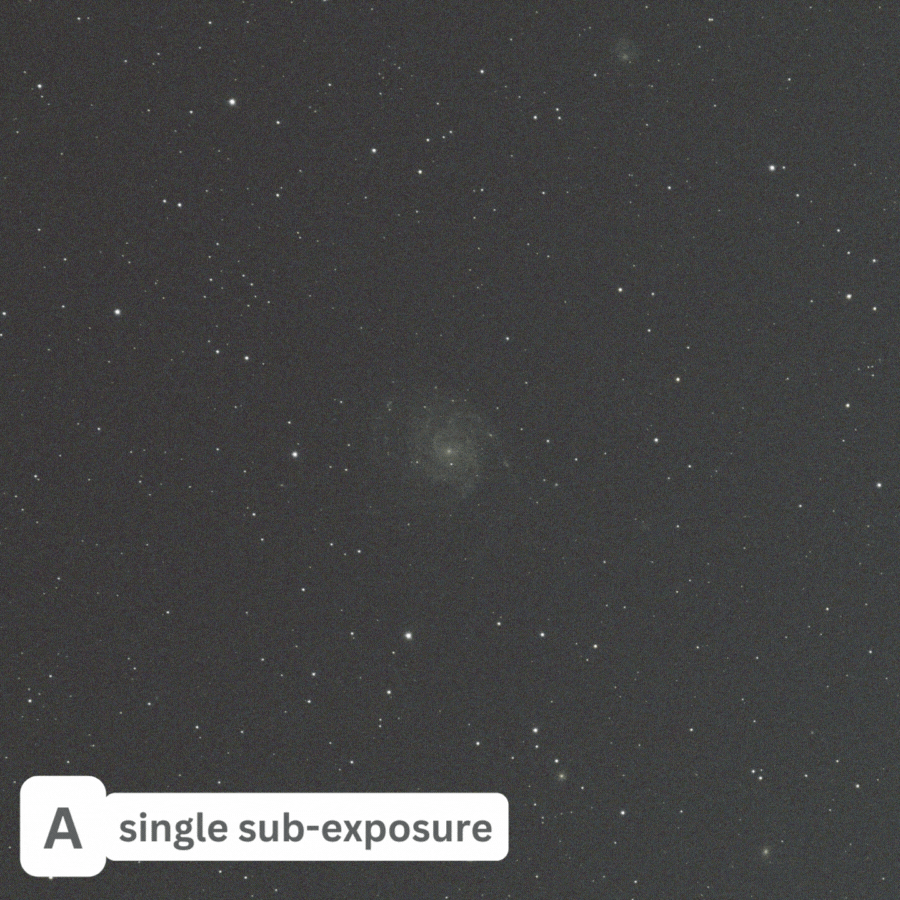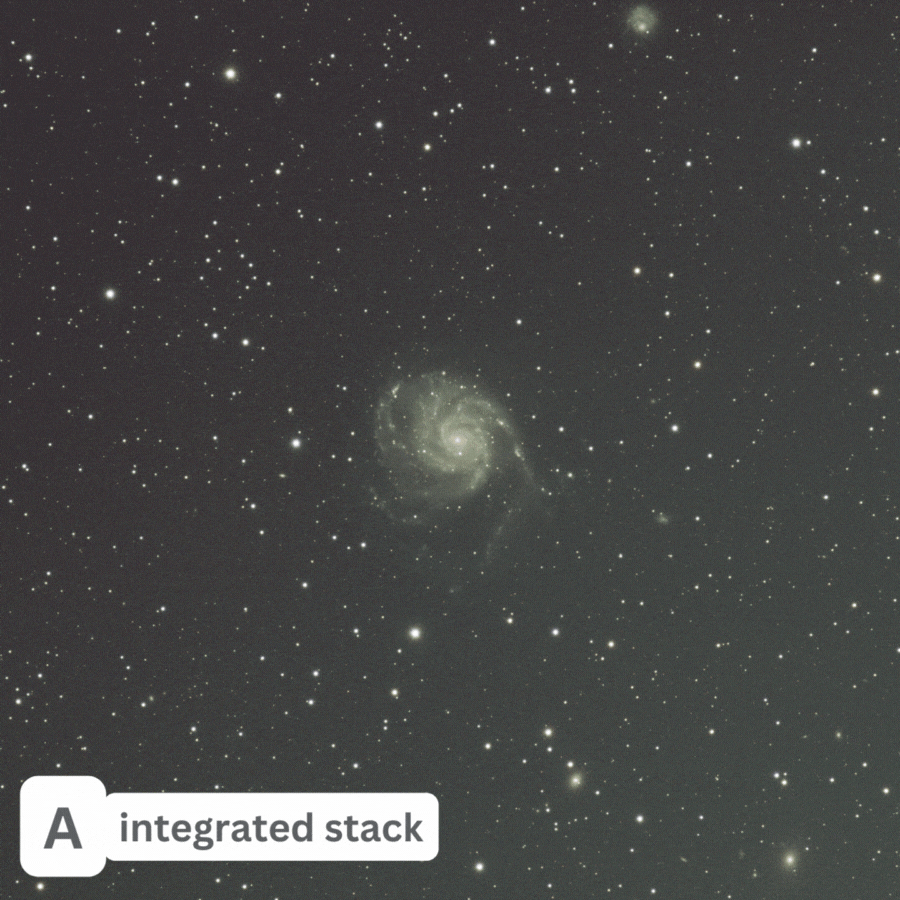The Night Sky - Episode 16
THE PINWHEEL GALAXY
This is episode 16 in my series on our night sky
Over the past few years, I have been working my way up to capturing a particular deep space object that’s massive yet tiny from our viewpoint, distant yet proximate in the vast emptiness of the universe, and challenging to capture accurately while bringing to life aesthetically. A sprawling expanse that beckons from the depths of space, teasing with its elusive beauty and tantalizing in its mystique.
This is my attempt at capturing the Pinwheel Galaxy.
The Pinwheel Galaxy (M101). A total of 192 exposures of 3 minutes each were shot to complete this image.
Image by Achint Thomas
The Pinwheel Galaxy, designated M101, is a spiral galaxy situated approximately 21 million light-years away from Earth in the constellation Ursa Major. Its sheer size is awe-inspiring, spanning about 170,000 light-years in diameter, making it roughly twice the size of our Milky Way galaxy. This galaxy is characterized by its prominent spiral arms adorned with regions of intense star formation and numerous star clusters and nebulae sprinkled throughout its structure.
Locating M101
Positioned within the constellation Ursa Major, M101 can be easily located by observers in northern latitudes. To locate M101, identify the prominent asterism known as the Big Dipper, which forms part of the larger Ursa Major constellation. M101 forms one vertex of the equilateral triangle consisting of Alkaid and Mizar, the last two stars of the Big Dipper’s “handle.”
Star chart showing how to locate M101 in the night sky. The key is to locate the one of the most famous asterisms in the northern skies — The Big Dipper. This asterism is visible year-round in the northern hemisphere. [image reference]
M101 is not visible to the naked eye due to its low surface brightness. Using magnification, under very dark skies away from light pollution, M101 may appear as a faint, elongated smudge of light, reminiscent of a cosmic pinwheel adrift in the vastness of space. Utilizing star charts, astronomy apps, or GoTo telescopes can aid in pinpointing the precise location of M101.
Multi-night Endeavour
Astrophotography is not merely a single-night endeavour but often requires multiple imaging sessions to gather sufficient data to reveal the structure and details of faint deep space objects. In my quest to capture M101, I embarked on a multi-night astrophotography campaign. Each night presented its own set of challenges and opportunities, from battling intermittent clouds to fighting the light from the moon by optimizing exposure times and imaging parameters. By diligently capturing data across multiple nights, I was able to mitigate the effects of atmospheric turbulence and light pollution, resulting in a cleaner, more detailed image that reveals the intricate details of M101's spiral arms and star-forming regions.
(A) A single 3-minute sub-exposure of M101 taken under Bortle 5 skies
(B) Integrated stack of 192 sub-exposures totalling 9.6 hours across three nights of light collected
Integrating the data acquired across multiple nights is a critical aspect of multi-session astrophotography. It allows astrophotographers to combine individual exposures to enhance signal-to-noise ratio and reveal faint details. As shown in the image above, through meticulous calibration, alignment, and stacking of the individual images (sub-exposures), I was able to enhance the clarity and definition of M101's structure while preserving the integrity of its colours and features.
Multi-step Image Processing
Capturing raw data is just the beginning of the journey. Transforming the collected data into stunning astro images involves a series of meticulous processing steps aimed at removing unwanted light gradients, calibrating colour for scientific accuracy, enhancing details, reducing noise, and revealing the true beauty of celestial objects.
Gradient Removal
Gradient removal is a crucial initial step in astro image processing, aimed at correcting uneven illumination caused by various factors such as city light pollution, skyglow, and the light from the moon. These gradients manifest as subtle variations in brightness across the image, obscuring faint details and diminishing the overall quality of the astro image. To address this challenge, astrophotographers employ specialized gradient removal techniques to restore uniformity and clarity to their images. Common methods include background subtraction, where a reference frame devoid of celestial objects is used to subtract the background gradient from the original image, and polynomial fitting, which utilizes mathematical algorithms to model and remove the underlying gradients.
Colour Calibration
Since different imaging setups and camera sensors may introduce subtle variations in colour rendition, colour calibration is performed to ensure an accurate representation of celestial hues. By comparing the colours of known reference stars from scientific sky survey datasets, astrophotographers can correct for sensor imperfections and achieve true-to-life colours in their images.
(A) Integrated image stack
(B) After applying gradient removal, the light pollution has been removed. Notice how the image background is now more uniform.
(C) Spectrophotometric colour calibration is applied to correct for any colour inaccuracies. This step maps the colours of the stars in the image to the expected colours of the stars based on scientific observations to correct any colour shifts introduced by the camera sensor and filters used. Notice how the greenish-yellow cast has been reduced.
Deconvolution
Deconvolution is a powerful technique employed to enhance the sharpness and clarity of astronomical images. In essence, deconvolution algorithms reverse the blurring effects introduced by the atmosphere, telescope optics, and camera sensors. By iteratively refining the imaging system's point spread function (PSF), deconvolution algorithms can restore fine details and unveil hidden structures within the captured data. This iterative process requires careful parameter tuning to balance detail enhancement with noise suppression, ultimately yielding sharper and more detailed astro images.
Noise Reduction
Noise reduction is a fundamental aspect of astro image processing that aims to minimize the impact of thermal and sensor noise inherent in long-exposure images. By applying advanced noise reduction algorithms, astrophotographers can unveil faint details and enhance the overall quality of their images, resulting in cleaner and more visually appealing astro images.
(A) Zoomed-in view of the center of the galaxy
(B) Deconvolution is used to correct for the atmospheric dispersion of the light reaching us from deep-space objects. Notice how the stars appear tighter, and dust lanes in the galaxy appear sharper compared to before deconvolution.
(C) Even with many hours of light collected, the Signal-to-Noise ratio of astro images is still quite low. Noise reduction must be applied to improve the image. Notice how the salt-and-pepper noise has been greatly reduced.
Contrast Enhancement
Histogram stretching, also known as contrast enhancement, is a transformative step in the image processing workflow to optimize the dynamic range and contrast of astro images. By stretching the histogram of pixel intensities, astrophotographers can expand the tonal range of the image, revealing both faint details and vibrant features that may be obscured in the original data. Through careful adjustment of contrast and brightness parameters, histogram stretching enables astrophotographers to accentuate the intricate structures and subtle nuances of celestial objects, resulting in visually striking and immersive astro images.
(A) Image after colour calibration, deconvolution, and noise reduction
(B) Final image after histogram stretching
In the culmination of these image processing steps, astrophotographers meticulously refine and enhance their raw data to produce captivating astro images that convey the awe-inspiring beauty of the cosmos. Through the convergence of advanced processing techniques, innovative algorithms, and the creative vision of the astrophotographer, the celestial wonders captured in raw data are transformed into breathtaking works of art that inspire wonder and curiosity, inviting viewers to embark on a journey through the depths of the universe.
Nearby Neighbours
Near the sprawling beauty of M101, several other notable deep space objects adorn the cosmic landscape, adding to the richness of the celestial tapestry. Among these companions is NGC 5474, a dwarf irregular galaxy nestled near M101. Despite its diminutive size, NGC 5474 boasts intricate structures and regions of active star formation, offering insights into the dynamics of galaxy evolution. Nearby, NGC 5485 captivates with its spiral arms and stellar populations, contributing to the diverse stellar ensemble surrounding M101. Additionally, NGC 5471, an emission nebula illuminated by the radiance of young, hot stars, adds a splash of vibrant colours to the cosmic tableau. Alongside these galaxies and nebulae, several star clusters dot the region, including young, luminous clusters that serve as nurseries for newborn stars. Together, these deep space objects form a captivating celestial neighbourhood, inviting astrophotographers and astronomers alike to further explore the mysteries of the cosmos surrounding M101.
Annotated image of the celestial neighbourhood of M101
Image by Achint Thomas
The process of capturing the Pinwheel Galaxy (M101) has been an exciting odyssey into the heart of the cosmos. By combining specialized equipment, advanced imaging techniques, and the perseverance of multi-session astrophotography, I have strived to reveal the celestial allure of a remote spiral galaxy, beckoning viewers to marvel at the splendours embellishing our cosmos. As we peer into the depths of space, may the beauty of galaxies like M101 inspire us to continue exploring the boundless treasures of the cosmos and ignite a sense of wonder and curiosity that challenges the limits of our imagination.
Check out some other galaxies I have captured.
Capture details
Camera: ZWO ASI 533MC Pro
Gain: 100
Sensor Temperature: -20°C
Lens: Sigma 100-400mm f/5-6.3 DG OS HSM
Focal length: 400mm (equivalent of 1080mm full-frame)
f-Ratio: 6.3
Sub-exposure length: 180 seconds
Number of exposures: 192 (with Optolong L-Quad-Enhance filter)
Total integration time: 9.6 hours
Calibration frames: 30 darks, 30 flats, 30 dark flats
Mount: SkyWatcher Star Adventurer GTi
Guide camera: ZWO 120mm mini
Guide scope: ZWO Mini Guide scope
Capture control: ZWO ASIAir Pro
Dew control: SvBony dew heater
Field Power: AIMTOM 194Wh Portable Power Station
Sky quality: Bortle 5
Moon phase: 75% to 100%
Processing: PixInsight








